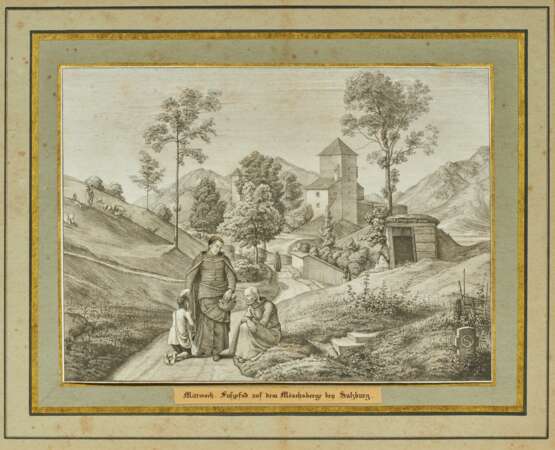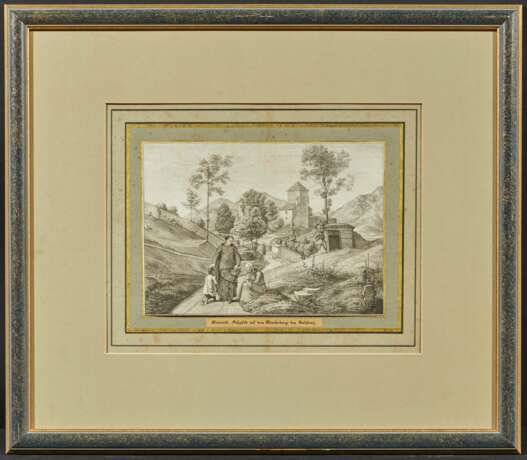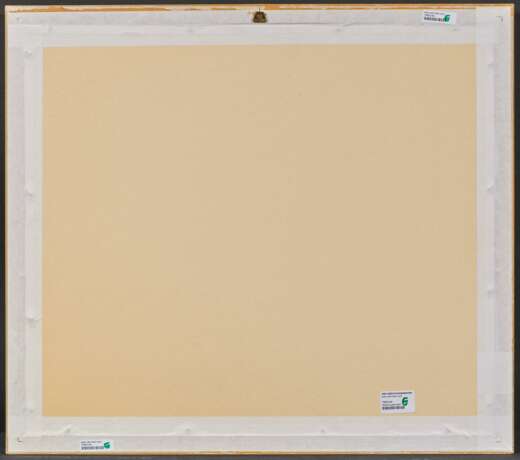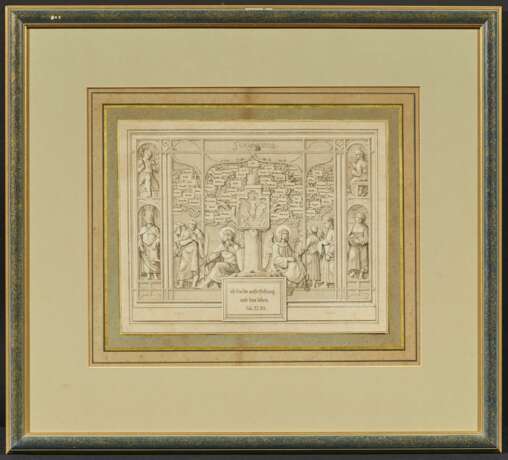ID 951155
Los 130 | Ferdinand Olivier
Schätzwert
€ 20 000 – 30 000
Title: "Sieben Gegenden aus Salzburg und Berchtesgaden. Geordnet nach den sieben Tagen der Woche, verbunden durch zwey allegorische Blätter".
Date: 1818/23.
Set of nine sheets of the so-called "Liebhaberausgabe" with gilt framing on grey-green card and single-line subtitles on brown label below the illustration. With the original slipcase binding.
Sunday. Church entrance in Berchtesgaden.
Monday. Rosenecker garden in front of Salzburg.
Tuesday. Bergveste Salzburg from the noon side.
Wednesday. Footpath on the Mönchsberg near Salzburg.
Thursday. Berchtesgaden and the Watzmann.
Friday. Meadow plan in front of Aigen near Salzburg.
Saturday. God's Acre at St Peter's in Salzburg.
Dedication. John XI, 25.
Keystone. John XX, 29..
Technique: Chalk lithographs on paper.
Mounting: Original mounting.
Measurement: Each ca. 19,5 x 27,5cm, resp. 28,5 x 37,5cm.
Frame: Framed individually.
Nagler, Künstlerlexikon 1924, vol. 11, p. 453;
Exh. Cat. German Printmaking in the Age of Goethe, edited by A. Griffiths and F. Carey, London 1994, pp. 209-214, no. 135;
G. Bartrum / D. Goffrey in: Ausst. Cat. Wahlverwandschaften, An English Private Collection on the Art of the Goethe Period, Weimar 2013, pp. 246-265, no. 65.
Provenance:
Private collection, Germany, acquired in 1990 from C.G. Boerner, Düsseldorf.
The present series of nine chalk lithographs by Ferdinand Olivier is an important major work of German Romanticism and is considered an absolute highlight of any graphic collection dealing with 19th century art. The work consists of nine plates made between 1818 and 1822 and advertised by Olivier the following year under the above title. Seven of the prints are landscapes. They have titles that name the day of the week they depict and the respective view of Salzburg and Berchtesgaden. At the beginning and end are two further plates, a dedicatory leaf and an allegorical "keystone", both drawn in the style of bas-relief sculptures.
Ferdinand Olivier first visited Salzburg in the summer of 1815 and was so deeply impressed by the beauty of the majestic Alpine landscape and its picturesque villages that he returned two years later with his brother Friedrich as well as Julius Schnorr von Carolsfeld to make further drawings. With a wealth of sketches in his luggage, he travelled back to Vienna, where he worked them into finished pen and ink drawings. At the beginning of 1818, Olivier planned to etch a set of several views, of which, however, he only completed two: the sheets for Monday and Tuesday. The character of the etched line was too different from the gossamer touch of his pencil drawings. He found the appropriate medium in the still young technique of lithography, which met with great interest in the Nazarene circle: the new reproduction process had the special ability to perfectly reproduce the old-masterly delicate stroke and tonal values of his hand drawings.
The result are outstanding landscape depictions that mark the high point of early German lithographic history, both technically and artistically, as well as in their scope. And yet they are not pure landscape paintings. The entire week represents at the same time a subtly allusive allegory of the Christian life, expressing an immanent spirituality in the relationship between everyday human life and nature. Thus, the carpenter and his family going about their work on a busy Monday morning outside the gates of old Salzburg recall the childhood of Christ. The hunter and the goatherd on Tuesday tell of Jacob's encounter with Rachel as she watered her father's sheep, while the harvesters in medieval dress do their work in front of a wayside cross on Friday. The week begins with the baptism on Sunday and ends with the burial on Saturday.
| Künstler: | Ferdinand Johann von Olivier (1785 - 1841) |
|---|---|
| Kategorie des Auktionshauses: | Antike Grafiken |
| Künstler: | Ferdinand Johann von Olivier (1785 - 1841) |
|---|---|
| Kategorie des Auktionshauses: | Antike Grafiken |
| Adresse der Versteigerung |
VAN HAM Kunstauktionen GmbH Hitzelerstr. 2 50968 Köln Deutschland | ||||||||||||||
|---|---|---|---|---|---|---|---|---|---|---|---|---|---|---|---|
| Vorschau |
| ||||||||||||||
| Telefon | +49 221 92586215 | ||||||||||||||
| Fax | +49 221 92 58 62 4 | ||||||||||||||
| Aufgeld | 32% | ||||||||||||||
| Nutzungsbedingungen | Nutzungsbedingungen | ||||||||||||||
| Geschäftszeiten | Geschäftszeiten
|
































